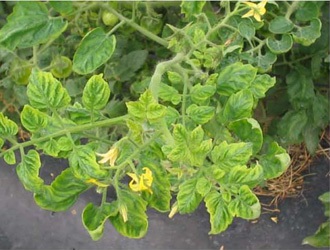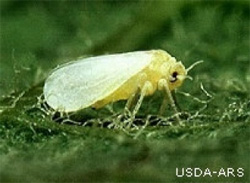Tomato yellow leaf curl virus
Amendments to PS–55: Treatment and inspection of plants for tomato yellow leaf curl virus and vector (silverleaf white fly)
For staff treating and inspecting plants, PS-55 explains the:
- principles
- responsibilities
- how to operate, and actions.
This ensures compliance with interstate import rules for tomato yellow leaf curl virus (TYLCV) under an accreditation arrangement.
Minor changes have been made to the procedure. For more details, see the biosecurity update ![]() [PDF File - 228.9 KB].
[PDF File - 228.9 KB].
What is tomato yellow leaf curl virus?
Tomato yellow leaf curl virus (Begomovirus coheni; TYLCV) can infect over 30 different kinds of plants, but it is mainly known to cause devastating losses of up to 100 per cent in the yield of tomatoes. Both field and glasshouse-grown tomatoes are susceptible.
TYLCV is vectored by silverleaf whitefly (Bemisia tabaci). Following detections in recent years, silverleaf whitefly is now considered established in Victoria.
TYLCV is a begomovirus, implying it has a wide host range on dicotyledons. There are two strains of TYLCV, a mild strain and a severe strain. The mild strain was considered responsible for the recent detection of TYLCV in tomato and weed plants in northern Victoria (David Lovelock pers. comm). The severe strain infects bean and tomato.
Symptoms of TYLCV
The most obvious symptoms in tomato plants are small leaves that become yellow between the veins. The leaves also curl upwards and towards the middle of the leaf (Figure 1).

In seedlings, the shoots become shortened and give the young plants a bushy appearance. In mature plants only new growths produced after infection is reduced in size. Although tomato production is reduced by the infection, the fruit appears unaffected.
Spread of TYLCV
TYLCV is transmitted from diseased to healthy plants by silverleaf whitefly, which feeds on a wide range of hosts (Figure 2). Levels of TYLCV can be correlated to the population size of its vector silverleaf whitefly. It is not known if native whiteflies can spread the virus.
The TYLCV strain occurring in Australia is not known to be seed transmitted or to be transmitted mechanically.

Hosts of TYLCV
TYLCV mainly infects tomatoes but has also been reported on glasshouse grown Capsicums. Bean (Phaseolus vulgaris) (Figure 3), petunia (Petunia x hybrida), and lisanthus (Eustoma grandiflorum) show severe symptoms.
Weeds such as thorn apples (Datura stramonium) can show symptoms, others such as Marsh mellow (Malva parviflora) are symptomless carriers, while cotton and aubergine, are immune to the virus.
List of common hosts of TYLCV (Walker 2006)
- Erect tar vine or erect spider vine (Boerhavia erecta)
- Capsicum or chilli pepper (Capsicum annuum and Capsicum chinense)
- Tick weed (Cleome viscose)
- Lobed croton (Croton lobatus)
- Cyanchum acutum (common name unknown)
- Common thorn apple (Datura stramonium)
- Euphorbia spp.
- Lisianthus (Eustoma grandiflora)
- Tomato (Lycopersicon esculentum)
- Macroptilium spp.
- Small-flowered mallow (Malva parviflora and other Malva spp.)
- Mercurialis ambigua (common name unknown)
- Beans (Phaseolus vulgaris)
- Physalis spp.
- Knot weed or wire weed (Polygonum spp.)
- Sida spp.
- Blackberry nightshade (Solanum nigrum)
- Hairy nightshade (Solanum luteum or Solanum villosum)
- Wissadula spp.
TYLCV symptoms on bean
TYLCV (severe strain) infection on bean leaves has symptoms of yellow mosaic, crumpled, thickened and curled upwards or downwards leaflets (Figure 3). Apical and side shoots show abnormal growth (Figure 3). Fruit production is severely limited under glasshouse conditions.
Younger plants seem to be more susceptible to TYLCV or perhaps more attractive to the vector and hence the disease is more severe on plant infected at this stage. When grown together, tomato plants seem to be more susceptible than bean plants to TYLCV (Papayiannis et al 2007).

Epidemiology of TYLCV
TYLCV infected plants tend to be found randomly or in patches in a crop.
Overseas, all greenhouses infested with high populations of silverleaf whitefly have tomatoes infected with TYLCV. Autumn grown crops were the worst infected with TYLCV and crop losses were described as ‘drastically reduced’.
Distribution of TYLCV
TYLCV originated in the eastern Mediterranean in the 1960’s and spread worldwide, becoming a serious problem for tomato production.
The world-wide spread of TYLCV is suspected to be associated with the movement of commercial tomato and ornamental plants contaminated with virus infected whitefly.
It was eradicated from the Netherlands in 2008.
TYLCV was first detected in Australia in early 2006 in Brisbane on cherry tomatoes and in Bundaberg in both commercial and home garden tomatoes. TYLCV is also present in the Northern Territory.
Distinguishing TYLCV from other conditions
TYLCV can be confused with other diseases and disorders.
List of disease and disorder symptoms similar to TYLCV (Walker 2006)
Disease or disorder | Symptom description |
|---|---|
Tomato big bud | Produces big buds and green flowers |
Tomato yellow top virus | Leaflets are reduced in size and rounded with yellowish down-curled or up-curled margins |
Physiological leaf roll (water stress) | Young expanding leaves are soft, not rigid and stunting is absent |
Phosphate deficiency | Purplish tinge to whole plant, stiff and stunted plants |
Magnesium deficiency | Interveinal yellowing of middle and lower leaves |
Reporting an unusual plant pest or disease
Report any unusual plant pest or disease immediately using our on-line reporting system. Early reporting increases the chance of effective control and eradication. Please take good quality photos of the pests or damage to include in your report where possible.
Alternatively, you can call the Exotic Plant Pest Hotline on 1800 084 881
Report onlineReferences
Czosnek H, 2020. Tomato yellow leaf curl virus (leaf curl). Crop Protection Compendium. Wallingford, UK: CABI. DOI:10.1079/CPC.55402.20210104831
Navas-Castillo J, Sanchez-Campos S, Diaz JA, 1999. Tomato yellow leaf curl virus causes a novel disease of common bean and severe epidemics in tomato in Spain. Plant Disease, 83:29-32.
Papayiannis, LC, Paraskevopoulos, A, Katis, NI, 2007. First report of Tomato yellow leaf curl virus infecting common bean (Phaseolus vulgaris) in Greece. Plant Disease, 91(4), 465. doi: 10.1094/PDIS-91-4-0465C
Walker K, 2006 Tomato yellow leaf curl virus (TYLCV) (Tomato yellow leaf curl virus (TYLCV) Begomovirus)
Photo credits
Figure 1 John Thomas, Queensland Department of Industries and Fisheries
Figure 2 W. Billen, Pflanzenbeschaustelle, Weil am Rhein, Bugwood.org
Figure 3 Navas Castillo et al.